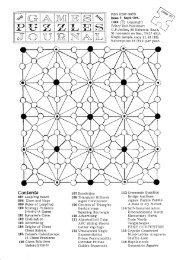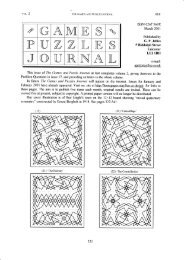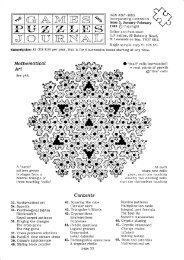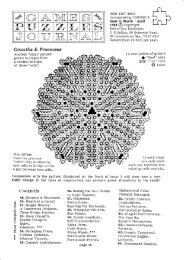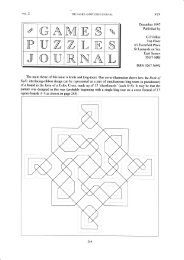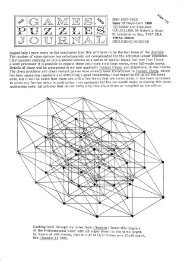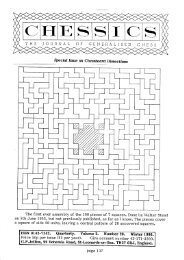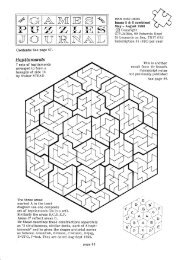The Games and Puzzles Journal, #8+9 - Mayhematics
The Games and Puzzles Journal, #8+9 - Mayhematics
The Games and Puzzles Journal, #8+9 - Mayhematics
Create successful ePaper yourself
Turn your PDF publications into a flip-book with our unique Google optimized e-Paper software.
page 118 THE GAMES AND PUZZLES JOURNAL issue 8+9<br />
ZINES & MAGS<br />
Tlte <strong>Games</strong> <strong>and</strong> <strong>Puzzles</strong> <strong>Journal</strong>. Apologies for the late appearance of this issue. Itve<br />
attowuetoworkonmyotherproJects,suchastheChessays.<br />
Actual publication date for this issue is 23 April 1989. I hope to catch up by issue L2 at least.<br />
<strong>Games</strong> Monthly. My prediction that this magazine looked like a stayer could not have<br />
been ilffii6fr$ITToloed after only four issues. Nominally it is being incorporated into <strong>Games</strong><br />
International, but this appears to be only a commercial deal, allowing the latter to take over<br />
the formerrs subscription list <strong>and</strong> distribution network, not a combining of editorial input.<br />
<strong>Games</strong> International. This, the third of the new games magazines, at last reached me<br />
atiss@scription,askingforittostartatNo.1,butitSeemSthatbackissues<br />
are already unavailable. <strong>The</strong> address is: Lamerton House, 23a High Street, Ealing, London<br />
W5 5DF. In format it is between <strong>Games</strong> Monthly <strong>and</strong> <strong>Games</strong> Review - with larger type than<br />
thelatter,colouronlyonthecover|6iTffimecnaniGrlayoE.Tnisissuecontainsartic1es<br />
surveying Election games <strong>and</strong> Trivia quizzes - neither of which inspire me with enthusiasm.<br />
Ac*mong is another zine that got missed out of the survey in G&PJ 1. It comes from<br />
corOfrTic-o-diald, tBenbecula', 3 Taylor Park, Scroggy Road, Limava@4g ONT. Besides<br />
Diptomacy <strong>and</strong> its variants its main theme is Early Irish History.<br />
VARIOUS BOAR D GAMES<br />
Tliangular Nimmity. Len Gordon writes that a similar game, under the name 'Japanese<br />
Corn Game' appears in a booklet called Puzzle Craft published by Lynn Rohrbough in 1930.<br />
It uses a fiveja-side triangle, but ooes n6l-lffiseJfre restriction that the pattern must not<br />
be disconnected. Also Martin Gardner describes a Square Nimmity, called 'Tac Tixt, <strong>and</strong> some<br />
other varieties in Mathematical <strong>Puzzles</strong> <strong>and</strong> Diversions (Pelican Books 1965), where the idea<br />
isattributedtoPist(19s8)beenre.issuedbyUniversity<br />
of Chicago Press under the title Hexaflexagons <strong>and</strong> other Mathematical Diversions.<br />
<strong>The</strong> Game Invention Competition - 1988<br />
<strong>The</strong> prize for the rgame invention competitiont announced on p.53 (issue 4) has been won<br />
by Stephen Taylor for his version shown opposite employing custodian eapture. Various other<br />
alternative systems of rules are also described. <strong>The</strong>y all begin with the pieces set up as for<br />
Draughts except that the White pieces are on Black squares <strong>and</strong> the Black pieces on White<br />
squares, <strong>and</strong> the pieces remain on these colour squares throughout the play.<br />
Two4olour Checkers. Michael Keller sent a description of this game from Nost-Algia<br />
Numu@98?(aU.S.'zinethatI'veheardofbutneverseen).Mann]ftharosh<br />
<strong>and</strong> Gamy Crum played a test game in 1974 under the rules: all moves as in normal Checkers<br />
except that captures are by short jumps forward along the files for Pawns, <strong>and</strong> in any direction<br />
for Kings. M.C. wrote: 'We agreed that there is not sufficient variety in the play. One error<br />
seems to be enough to lose a game. A king plays havoc quickly because it can approach an<br />
opposing plain man on 3 sides, <strong>and</strong> often cannot be stopped from capturing 3, 4 or even 5 at<br />
a time. Yet the idea is so intriguing that I wish you could amend the rules to increase the possibility<br />
of stratagems for both offense <strong>and</strong> defense.' (letter to Philip M.Cohen).<br />
Directional Draughts. This is my own suggested set of rules for the game.<br />
<strong>The</strong> pieces move one square at a time diagonally, <strong>and</strong> capture by series of short Jumps<br />
along ranks or files - but there are restrictions on these, as follows. Moves may only be made<br />
directly towards or away from allied men, whereas captures may not be made towards or away<br />
from allied men. Thus, White can start by c3-b4 (away from d2) but not by a3-b4. Black can<br />
then follow with c6-b5 without fear of capture by b4-b6 etc (since this move is away from<br />
b2). If White now plays b2-c3 however, the capture b4-b6 is now threatened <strong>and</strong> Black can<br />
defend by b5-a4 (threat a4-c4) or b5-c6, retreating. If a piece (or more than one) finds itself<br />
on its side's turn to move occupying a square where it is not blocked in any of the four diagonal<br />
directions but is nevertheless unable to move or capture, then it promotes to theror, <strong>and</strong><br />
is released from the above restrictions. <strong>The</strong> obJect is to capture or immobilise the opposition.




